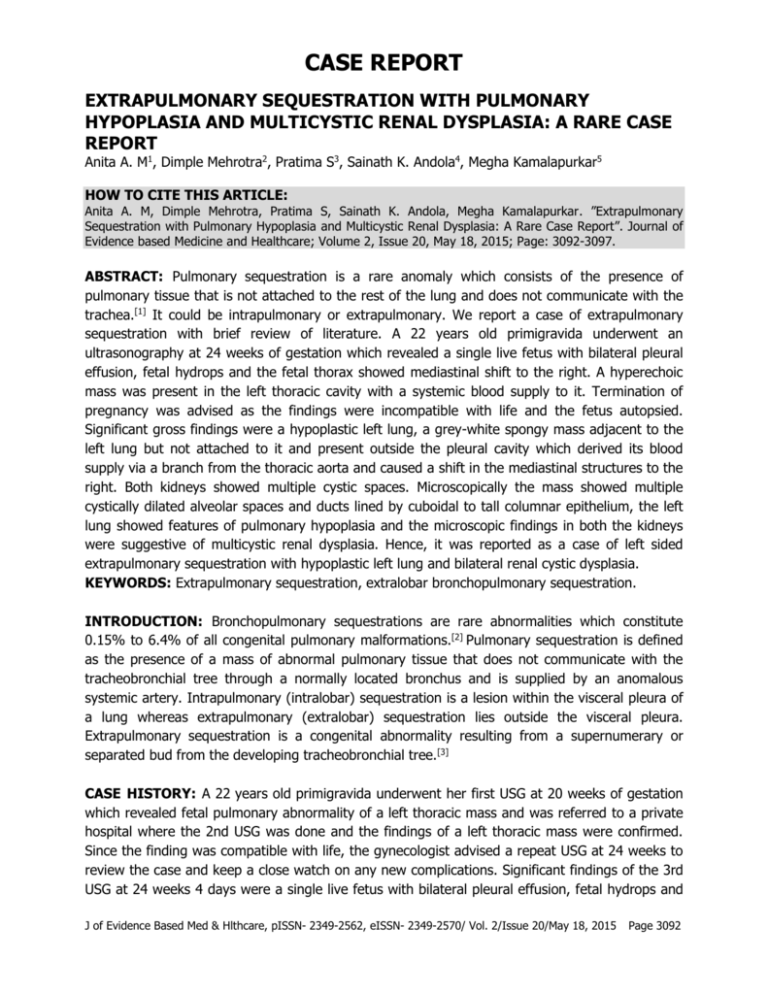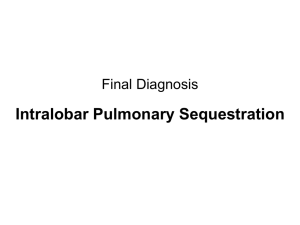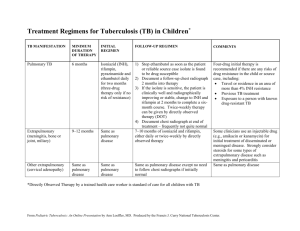extrapulmonary sequestration with pulmonary hypoplasia and
advertisement

CASE REPORT EXTRAPULMONARY SEQUESTRATION WITH PULMONARY HYPOPLASIA AND MULTICYSTIC RENAL DYSPLASIA: A RARE CASE REPORT Anita A. M1, Dimple Mehrotra2, Pratima S3, Sainath K. Andola4, Megha Kamalapurkar5 HOW TO CITE THIS ARTICLE: Anita A. M, Dimple Mehrotra, Pratima S, Sainath K. Andola, Megha Kamalapurkar. ”Extrapulmonary Sequestration with Pulmonary Hypoplasia and Multicystic Renal Dysplasia: A Rare Case Report”. Journal of Evidence based Medicine and Healthcare; Volume 2, Issue 20, May 18, 2015; Page: 3092-3097. ABSTRACT: Pulmonary sequestration is a rare anomaly which consists of the presence of pulmonary tissue that is not attached to the rest of the lung and does not communicate with the trachea.[1] It could be intrapulmonary or extrapulmonary. We report a case of extrapulmonary sequestration with brief review of literature. A 22 years old primigravida underwent an ultrasonography at 24 weeks of gestation which revealed a single live fetus with bilateral pleural effusion, fetal hydrops and the fetal thorax showed mediastinal shift to the right. A hyperechoic mass was present in the left thoracic cavity with a systemic blood supply to it. Termination of pregnancy was advised as the findings were incompatible with life and the fetus autopsied. Significant gross findings were a hypoplastic left lung, a grey-white spongy mass adjacent to the left lung but not attached to it and present outside the pleural cavity which derived its blood supply via a branch from the thoracic aorta and caused a shift in the mediastinal structures to the right. Both kidneys showed multiple cystic spaces. Microscopically the mass showed multiple cystically dilated alveolar spaces and ducts lined by cuboidal to tall columnar epithelium, the left lung showed features of pulmonary hypoplasia and the microscopic findings in both the kidneys were suggestive of multicystic renal dysplasia. Hence, it was reported as a case of left sided extrapulmonary sequestration with hypoplastic left lung and bilateral renal cystic dysplasia. KEYWORDS: Extrapulmonary sequestration, extralobar bronchopulmonary sequestration. INTRODUCTION: Bronchopulmonary sequestrations are rare abnormalities which constitute 0.15% to 6.4% of all congenital pulmonary malformations.[2] Pulmonary sequestration is defined as the presence of a mass of abnormal pulmonary tissue that does not communicate with the tracheobronchial tree through a normally located bronchus and is supplied by an anomalous systemic artery. Intrapulmonary (intralobar) sequestration is a lesion within the visceral pleura of a lung whereas extrapulmonary (extralobar) sequestration lies outside the visceral pleura. Extrapulmonary sequestration is a congenital abnormality resulting from a supernumerary or separated bud from the developing tracheobronchial tree.[3] CASE HISTORY: A 22 years old primigravida underwent her first USG at 20 weeks of gestation which revealed fetal pulmonary abnormality of a left thoracic mass and was referred to a private hospital where the 2nd USG was done and the findings of a left thoracic mass were confirmed. Since the finding was compatible with life, the gynecologist advised a repeat USG at 24 weeks to review the case and keep a close watch on any new complications. Significant findings of the 3rd USG at 24 weeks 4 days were a single live fetus with bilateral pleural effusion, fetal hydrops and J of Evidence Based Med & Hlthcare, pISSN- 2349-2562, eISSN- 2349-2570/ Vol. 2/Issue 20/May 18, 2015 Page 3092 CASE REPORT the fetal thorax showed mediastinal shift with the heart pushed to right (Figure 1).Mass in the left thoracic cavity was hyperechoic and enlarged and systemic blood supply noted to the mass (Figure 2). Termination of pregnancy was advised due to the combination of bilateral pleural effusion, fetal hydrops and the left thoracic mass which would have been incompatible with life. On autopsy, this female fetus weighed 1.1 kgs which was twice the normal weight of 560 grams for that age and was probably due to fetal hydrops, apart from that the fetus showed no external abnormalities (Figure 3). An ‘I’ shaped incision was given and the significant gross findings were a mass measuring 3.5x3x3 cms, grey-white in color, spongy in consistency, adjacent to the left lung but not attached to it and present outside the pleural cavity, causing a mediastinal shift to the right (Figure 4). This mass derived its blood supply via a branch from the thoracic aorta (Figure 4, 5, 6). Left Lung was small and hypoplastic measuring 2x1.5x0.5 cms (Figure 5).Both kidneys showed multiple subcortical cystic spaces (Figure 7). All other organs were normal grossly. Microscopically, the left thoracic mass showing multiple cystically dilated alveolar spaces and ducts lined by cuboidal to tall columnar epithelium (Figure 8 & 9). Left lung showed features of pulmonary hypoplasia with less than 5 alveolar spaces between the pleural surface and terminal bronchiole (Figure 10). The kidneys showed normal appearing glomeruli and premature tubules interspersed with cysts of varying sizes lined with cuboidal epithelium and surrounded by collars of spindle cells which were suggestive of multicystic dysplastic kidneys (Figure 11 & 12). All other organs were normal microscopically. Hence, it was reported as a case of left sided extrapulmonary sequestration with hypoplastic left lung and bilateral renal cystic dysplasia. DISCUSSION: Pryce was the first to classify Bronchopulmonary sequestration into intralobar or extralobar on the basis of the morphologic patterns.[4] In Intralobar bronchopulmonary sequestration an abnormal segment of lung tissue shares the visceral pleural covering of an otherwise normal pulmonary lobe and lacks normal communication with the tracheobronchial tree. Extralobar bronchopulmonary sequestration consists of a discrete accessory mass of nonaerated lung tissue that is invested by its own pleura. Its lack of communication with the normal bronchial tree precludes drainage of lung fluid and results in a loose, spongy tissue with numerous small cystic spaces containing clear, mucoid fluid. Massive pleural effusions are often associated, which was also seen in the present case. Other congenital anomalies are also associated with extrapulmonary sequestration as listed in Table-1, most commonly pulmonary hypoplasia which was seen in the left sided lung adjacent to the mass in the present case. On microscopy, uniformly dilated bronchioles and alveolar ducts are present with abnormal cartilage plates. Bronchioles and numerous papillary projections are lined by ciliated, tall columnar epithelium. Perivascular and subpleural lymphatics may be dilated and resemble lymphangiectasis. It histologically resembles normal lung tissue, although all structures are dilated. The venous drainage of extralobar bronchopulmonary sequestration is usually systemic, through the azygos, hemiazygos, or superior vena cava into the right atrium. Therefore, the major differentiating feature between intralobar and extralobar bronchopulmonary sequestrations is the venous drainage.[5] Other important differentiating features have been listed in Table 1. J of Evidence Based Med & Hlthcare, pISSN- 2349-2562, eISSN- 2349-2570/ Vol. 2/Issue 20/May 18, 2015 Page 3093 CASE REPORT Criteria Male: Female ratio Age Side of Lung involved Communication with the tracheobronchial tree Relation with the pleura Intrapulmonary sequestration 1:1 Usually >20 years Left Lung in 2/3rd cases esp. posterior basal segment Usually no communication Occurs within the pleural surface of normal lung tissue Association with other congenital anomalies Not associated Venous drainage Pulmonary Extrapulmonary sequestration 4:1 Usually <1 year Left Lung in almost all cases No communication Occurs completely enclosed within its own pleural sac Associated with- Bronchial atresia, pulmonary hypoplasia, duplication of colon, esophageal connection, cervical vertebral anomalies, diaphragmatic defect Systemic or Portal TABLE 1 Another finding in the present case was the presence of bilateral multicystic kidney dysplasia (MCDK) which develops in utero and the diagnosis is often made either antenatally or in the early neonatal period, if an ultrasound is performed. The incidence of MCDK at autopsy is about 0.03% and the cause is thought to be atresia at pelvi-ureteric junction.[6] The overall incidence of unilateral MCDK is 1 in 4300.[7] A dysplastic parenchyma anchors the cysts, the arrangement of which resembles a bunch of grapes. Typically, MCDK is a unilateral disorder; the bilateral condition is incompatible with life.[8] In a study conducted by Hong-Ning Xie et al, 22 cases of bronchopulmonary sequestration were diagnosed and combined anomalies were detected in 3 of 22 fetuses (13.6%) as follows: (1) a diaphragmatic hernia, a ventricular septal defect, renal ectopia, and short bones; (2) pulmonary stenosis; and (3) multicystic renal dysplasia.[9] This study is among the few studies reported which mention renal cystic dysplasia associated with extrapulmonary sequestration, as is being reported by us. In the present case due to a thoracic mass next to the lungs, causing pulmonary hypoplasia of the adjacent lung and associated with fetal hydrops, the main differential diagnosis was congenital cystic adenomatoid malformation but the presence of a systemic feeding artey arising from the aorta confirms the diagnoses of pulmonary sequestration. The advent of prenatal ultrasonography has enabled evidence that fetal pulmonary sequestrations can spontaneously regress although surgical resection of the involved area is recommended for extrapulmonary sequestration.[10] J of Evidence Based Med & Hlthcare, pISSN- 2349-2562, eISSN- 2349-2570/ Vol. 2/Issue 20/May 18, 2015 Page 3094 CASE REPORT CONCLUSION: Pulmonary sequestration is a congenital anomaly of lung development that can be intrapulmonary or extrapulmonary, according to the location within the visceral pleura. The majority of sequestrations are intrapulmonary. Here we discussed a case of extrapulmonary sequestration which is rarer out of the two subtypes; moreover it is four times more common in males whereas our case was that of a female fetus. Associated findings in the form of pulmonary hypoplasia and bilateral multicystic renal dysplasia have also been very rarely reported along with extrapulmonary sequestration. REFERENCES: 1. Enid Gilbert-Barness, Diane Debich-Spicer: Embryo and Fetal Pathology Color Atlas with Ultrasound Correlation; 1st ed, 2004. 2. Savic B, Birtel FJ, Tholen W, Funke HD, Knoche R. Lung sequestration: report of 7 cases and review of 540 published cases. Thorax 1979; 34: 96–101. 3. Enid Gilbert Barness.Potter’s pathology of the fetus, infant and child; 2nd ed, 2007. 4. Pryce DM. Lower accessory pulmonary artery with intralobar sequestration of lung: a report of 7 cases. J Pathol 1946; 58: 457–467. 5. S. Boopathy Vijayaraghavan, P. Sreekrishna Rao, C. D. Selvarasu, T. M. Subba Rao. Prenatal Sonographic Features of Intralobar Bronchopulmonary Sequestration. JUM May 1, 2003;22(5):541-544. 6. Johan G. Blickman, Bruce R. Parker, Patrick D. Barnes. Pediatric Radiology: The Requisites; 3rd ed, 2009. 7. Schreuder MF, Westland R, Van wijk JA. Unilateral multicystic dysplastic kidney: a metaanalysis of observational studies on the incidence, associated urinary tract malformations and the contralateral kidney. Nephrol. Dial. Transplant. 2009; 24 (6): 1810-8. 8. Hussain S, Begum N. Multicystic dysplastic disease of kidney in fetus. J Ayub Med Coll Abbottabad. Apr-Jun 2007; 19(2): 68-9. 9. Hong-Ning Xie, Li-Juan Li, Hua He, Hui-Juan Shi, Ruan Peng,Yun-Xiao Zhu: Prenatal Surveillance of Bronchopulmonary Sequestration Using 3-Dimensional Ultrasonography, J Ultrasound Med 2009; 28: 989–994. 10. Robert M. Kliegman. Nelson textbook of Pediatrics, 19th ed; 2011. Figure 1 Figure 2 J of Evidence Based Med & Hlthcare, pISSN- 2349-2562, eISSN- 2349-2570/ Vol. 2/Issue 20/May 18, 2015 Page 3095 CASE REPORT Figure 3 Figure 5 Figure 7 Figure 4 Figure 6 Figure 8 J of Evidence Based Med & Hlthcare, pISSN- 2349-2562, eISSN- 2349-2570/ Vol. 2/Issue 20/May 18, 2015 Page 3096 CASE REPORT Figure 9 Figure 10 Figure 11 AUTHORS: 1. Anita A. M. 2. Dimple Mehrotra 3. Pratima S. 4. Sainath K. Andola 5. Megha Kamalapurkar PARTICULARS OF CONTRIBUTORS: 1. Associate Professor, Department of Pathology, Mahadevappa Rampure Medical College, Kalaburagi, Karnataka. 2. Resident, Department of Pathology, Mahadevappa Rampure Medical College, Kalaburagi, Karnataka. 3. Professor, Department of Pathology, Mahadevappa Rampure Medical College, Kalaburagi, Karnataka. Figure 12 4. Professor & HOD, Department of Pathology, Mahadevappa Rampure Medical College, Kalaburagi, Karnataka. 5. Obstetrician & Gynaecologist, Devata Hospital, Kalaburgi, Karnataka. NAME ADDRESS EMAIL ID OF THE CORRESPONDING AUTHOR: Dr. Dimple Mehrotra, Department of Pathology, Mahadevappa Rampure Medical College, Sedam Road, Kalaburgi-585105, Karnataka. E-mail: drdimplemehrotra@gmail.com Date Date Date Date of of of of Submission: 13/05/2015. Peer Review: 14/05/2015. Acceptance: 16/02/2015. Publishing: 18/05/2015. J of Evidence Based Med & Hlthcare, pISSN- 2349-2562, eISSN- 2349-2570/ Vol. 2/Issue 20/May 18, 2015 Page 3097







